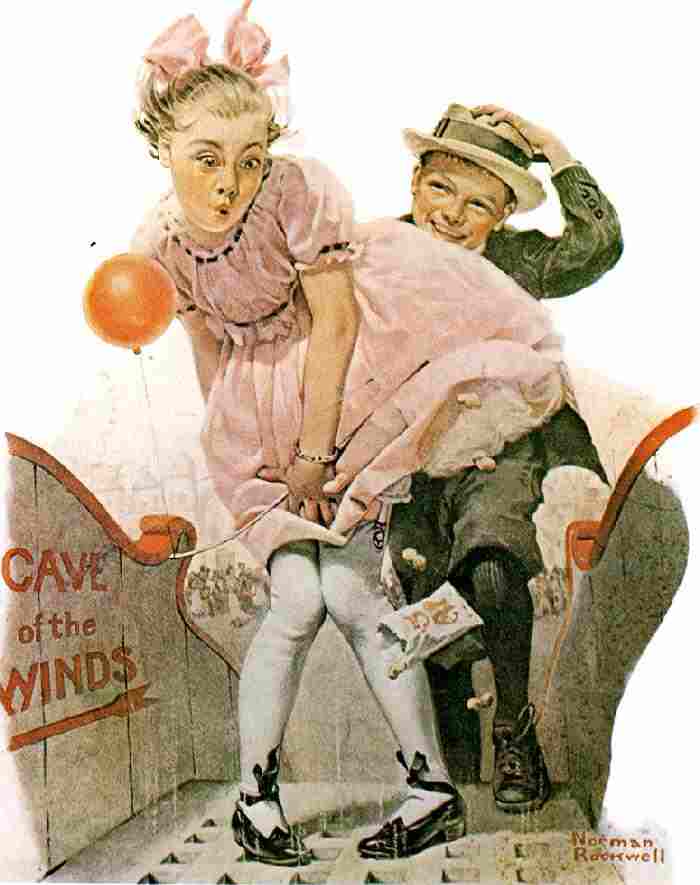
Figure 1.--Here we see a boy and girl at a fun fair. I believe this was the "Saturday Evening Post" cover for August 28, 1920. Note that the girl has white flat-weave stockings and the boy black-ribbed stockings.


Figure 1.--Here we see a boy and girl at a fun fair. I believe this was the "Saturday Evening Post" cover for August 28, 1920. Note that the girl has white flat-weave stockings and the boy black-ribbed stockings. |
A HBC reader writes, "I found this image in a second-hand shop (dated August 28, 1920). I believe it comes from a Saturday Evening Post cover (August 28, 1920), although I'm not entirely sure. Rockwell also did calendars, I think, or perhaps his covers were just reused for calendars. Anyway the childrens' clothing is interesting. The boy (about 9 or 10) wears a knicker suit (with knickers buckled above the knees) and long black ribbed stockings. Notice his straw hat with a ribbon and brim. The girl wears a pink dress with matching hair bow and long white stockings with hose supporters (you can see the clasp of one of her garters). She also wears black (probably patent leather) shoes with ankle ties. The children are obviously at a fun fair where they are experiencing "The Cave of the Winds" which blows their clothes. The girl has to hold down her dress and the boy must hold on to his hat. Altogether a rather sentimental but nevertheless charming scene, very typical of Rockwell's idealized, innocent, middle-class America."
One of the most well-known an beloved illustrators is Norman Rockwell. Rockwell's early illustrations were done for St. Nicholas magazine, the same magazine which first published Little Lord Fauntleroy. He also worked for other juvenille publications. He sold his first cover painting to the Saturday Evening Post in 1916 and ended up doing over 300 more. Presidents Eisenhower, Kennedy, and Johnson sat for him for portraits, and he painted other world figures, including Nassar of Egypt and Nehru of India. In his later years he addressed social issues like the Civil Rights movement. He is perhaps best known by many for his Scout drawings.
Rockwell sold his first cover painting to the Saturday Evening Post in 1916 and ended up doing over 300 more. The Post was the most popular American magazine in the first half of the 20th century and gave Rockwell access to a huge number of ASmerican homes. The early Post covers provide fascinating glimpses of children clothes. Rockwell was fascinated by children and many of the covered addressed their foibles and nicely illustrated their clothing. The Post covers include all areas of Americana, including presidential portraits. Presidents Eisenhower, Kennedy, and Johnson sat for him for portraits. He also painted other world figures, including Nassar of Egypt and Nehru of India.
The mass media was just beginning to develop in 1920. The movies became popular in the 1910s and after War commercial radio began. More Americans were adding record players to their parlors. Entertaiment was still limited. Thus amusement parts, carnivals and country and state fairs were very popular with children. Here one of the very popular attractions was the fun house. Rockwell here illustrates one common aspect of many fun houses--wind. At this fun house it was called the "Cave of Winds".
Illustrations do not have the same accuracy as a photograph. They hve the avantage of illustating an activity or event in away that is difficult for a photographer to capture. Norman Rockwell has often been criticized for paintain "an America that nevdr was". We think this is unfair. It is not doubt true that his drawings are often idealized. But we find most of them quite believeable. The illustration here is a case in point. Perhaps a bit idealized, but still quite believeable. We think like most illustrators they are a little dated, but not much here. Rockwell had an eye for detail and thus his work is a good reflection of clothing styles during his long career. Especially important is that he illustrated contemprarry scenes. Contemporary illustrations of course tends to be more accurate than historical illustrations.
One interesting aspect of the illustration here is how the children have dressed up to go to what is probaby an amusement park. That was not uncommon in the early 20th century, but would become much less common during the 1920s as casual dress becme increasingly popular after World War I. The girl here wears a pink dress with matching hairbow, long white stockings, and strap shoes. Note the bows on strap shoes. The accuracy of Rockwell's illustrations can be seen with the clasp of the stocking supporter shown. The bow ears a straw boater and knickers suit with long black ribbed stockings. We are not entirely sure how common these ribbed stockings were in the 1920s. The illustration does support the tradition that boys wore ribbed and girls non-ribbed stockings, although we know that this distinction is an over simplification. Flat-weave stockings seem to have been more common. And other Rockwell drawings, like "Travelling Companions", show the flat-weave stockings.
Navigate the Boys' Historical Clothing Artist pages:
[Return to the Main individual illustrator page]
[Chronology]
[Countries]
[Individuals]
[Styles]
Navigate the Boys' Historical Clothing Web Site:
[Return to the Main Rockwell body of work]
[Introduction]
[Activities]
[Biographies]
[Chronology]
[Clothing styles]
[Countries]
[Literary]
[Bibliographies]
[Contributions]
[FAQs]
[Glossaries]
[Satellite sites]
[Tools]
[Boys' Clothing Home]
